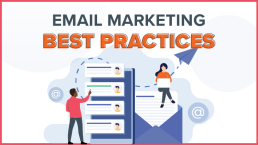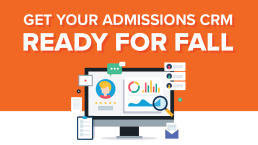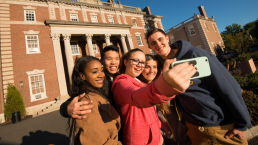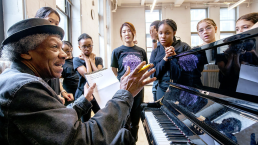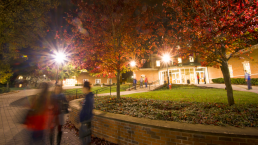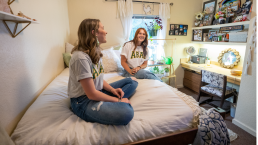Email Marketing Best Practices
Email Marketing Best Practices
Essential Tips for Elevating Your Communication Strategy
In today’s digital landscape, email remains a cornerstone of effective communication. They’re not just messages, but powerful tools that can create relationships, drive engagement, and so much more. So, whether you’re trying to get students to register for an event or trying to spread the word about a new program, mastering email best practices is essential for achieving your goals.
In this blog, I will delve into the core principles and strategies that support successful email communications. From crafting compelling subject lines to optimizing your email’s design and content, I’ll cover everything you need to know to enhance your email strategy. By adopting these best practices, you’ll be well-equipped to deliver clear, concise, and impactful messages with potential students and parents.
5 Key Factors to Perfect Before Hitting Send
When crafting your emails, it’s critical that the following key components are flawless:
- Subject Line & Preview Text
- Email Copy
- Call-to-Action Buttons
- Signature & Title
- Email Templates
1. Subject Line & Preview Text
Subject Line
The initial impression your recipient gets from your email is crucial. It determines whether they find it engaging enough to read further, delete it immediately, or even unsubscribe.
Creating the perfect email starts with making a personal connection right from the start, so use the data you have (first name, location, school name, relevant stats, etc.) to immediately grab your recipient’s attention. Be sure to keep the subject line concise, ideally under 70 characters, to ensure it’s fully visible on mobile devices and doesn’t get cut off.
Example: Apply to Spark University Today! —> Jane, Apply to Spark U’s Marketing Program Today!
Preview Text
The preview text should complement the subject line, offering additional value without being redundant. For example, if your subject line reads, “Jane, Apply to Spark U’s Marketing Program Today!” an effective preview text might be, “Our alumni help marketing students secure internships and real-world experiences.” This approach ensures the preview text provides new, enticing information that enhances the subject line, giving the recipient a compelling reason to open the email.
By strategically using the preview text to highlight unique benefits or important details, you can significantly improve open rates and engagement with your email content.
2. Email Copy
Incorporating dynamic content into your emails can significantly enhance personalization and engagement. By tailoring emails to include details such as the recipient’s preferred major, proximity to campus (local vs. non-local), or student status (prospect, applicant, admit, etc.), you create a more individualized and relevant experience for each student.
Let’s face it: each student is unique. Sending the same email to a large group won’t be as effective as sending a message that incorporates a few personalized touches.
Here are a few tips for creating more personalized emails:
- Use Dynamic Content: Make your emails feel personal by including specific information like the recipient’s preferences. Example: Marketing Major.
- Clear Call-to-Action (CTA): Ensure that your CTA is prominent and easy to follow throughout the entire email, including in the P.S. line. A clear CTA guides the recipient on the next steps and encourages them to take action.
- Utilize Bullets or Numbers: When presenting information, using bullets or numbers makes the content easier to read and digest. This format helps break down complex information into manageable pieces, making your email more reader-friendly.
Interesting Fact: Gen Z has an 8-second attention span for reading, so make sure those 8 seconds are impactful!
3. Call-to-Action Buttons
To maximize the effectiveness of your emails, it’s essential to strategically place and design your call-to-action (CTA) buttons. Here are some best practices that we follow:
- Position CTA Button Above the Fold: Place the primary CTA button near the top of the email, ensuring it is visible without scrolling on mobile devices. This increases the likelihood of engagement.
- Use Double CTA Buttons When Appropriate: This not only increases the chances of students clicking on your email, but also provides them with options. For example, you could include both “Learn More” and “Schedule Your Visit” buttons.
- Incorporate UTM Tracking Links: Always include UTM parameters in your links to track the effectiveness of your email campaigns and understand user behavior.
- Craft Clear & Urgent Button Copy: For single CTA emails, use concise and compelling language on your buttons (e.g., “Apply Today” instead of “Click Here to Apply”) to create a sense of urgency and drive action.
CTA buttons are crucial and should always be included. They are often the first elements that catch the reader’s attention, so it’s important to make a strong and meaningful first impression.
4. Signature & Title
To create a more personal and trustworthy connection with recipients, it’s best for emails to come from a real person or department. For example, an email could be signed by John Doe, Executive Director, Office of University Admissions. This approach adds credibility and a human touch to your communications. It’s also important to keep this information updated across all emails, as titles and personnel can change, to help ensure messages remain accurate and relevant. With the rise of phishing emails, maintaining the trust of our audience is essential!
5. Email Templates
Perfecting your email templates is also an essential step! There’s nothing worse than sending out a message with broken links, social media icons that don’t lead to the correct pages (this is especially important), or header images that don’t align with the email’s content. When creating your email template, be sure to keep the following points in mind.
- Include Links in All Images: Always ensure that all images in your email, especially header images, are linked. This can significantly boost your click-through-rate (CTR) by giving your recipient more chances to click.
- Optimize CTA Buttons: When designing call-to-action (CTA) buttons, make sure they include a link and are going to the correct page! If not, this might throw off the point of the email.
- Highlight Clickable Links: Make sure all clickable links stand out by using bold formatting, a different color, or underlining them. This helps to draw attention and encourage clicks.
- Personalization Is Key: Take advantage of personalization tokens such as First Name, Parent Name, Major, City, etc. Personalizing your emails can increase engagement and make your communications feel more relevant to the recipient.
- Verify Social Icons & Footer Links: Ensure all social icons and links in the footer of your email are correct and lead to the intended destinations. This not only provides additional engagement opportunities but also builds trust with your audience.
- Testing Your Template on Mobile and Desktop: Make sure your email template displays well on both mobile and desktop devices by checking its layout, images, and functionality across various screen sizes. Since many students frequently use their phones, this step is essential. Pro tip: Don’t forget to test your email in dark mode, as this feature is increasingly popular.
With thousands of colleges and universities sending billions of emails daily, it’s crucial that your emails not only stand out in the inbox but also keep the reader engaged once opened. Need a hand getting started? Reach out to learn more about how Spark451’s expert team can help support your email needs.
Top 5 Admissions CRM Focus Areas for Fall
Top 5 Admissions CRM Focus Areas for Fall
Make the Most of This Critical Season
By Jennie Bayless and Chris Gonzalez
Students settling in, classes starting, admissions teams gearing up to hit the road… it can only mean one thing: Fall semester is officially upon us! Before you get swept away with the busyness of the season, make sure you take the time to review our Top 5 Admissions CRM Focus Areas for Fall to help ensure you’re getting the most out of your CRM and effectively supporting Fall 2025 enrollment.
1. Fall Travel
Hundreds of hours are about to be spent on fall travel, with counselors and road warriors heading to high schools and college fairs throughout the country and abroad. Help them have a successful season and ensure your data stays clean by:
- Implementing an automated communication plan prepared for prospective students and high school counselors to let them know about upcoming travel plans.
- Watching, and having a plan, for duplicate records for organizations and CEEB codes.
- Leveraging travel-centric reports and tools (like Voyager if you’re in Slate).
- Using QR Codes at college fairs that direct students to inquiry forms. Or, for a more advanced approach, consider using them for online check-ins.
- Integrating with a vendor that enables you to leverage college fair inquiry forms.
2. Campus Visits
With fall comes a massive influx of campus visitors. In addition to making sure the grounds and buildings are in tip-top shape, pay attention to your database.
- Is your database ready to collect information about students’ guests? Parent information (thank-you notes and follow-up comms), sibling emails (future prospects) — they’re all important.
Pro Tip: Collecting parent information? Why not make a parent drip campaign? - Are your pre– and post-event communications built?
- Are you sending invitations?
- Event reminders?
- Are you reaching out to people who didn’t attend?
- Will you be sending post-event information and surveys?
3. Reporting
Don’t let the effort of collecting data go to waste — reporting is key!
- How are you reporting on your travel? Are you analyzing that information? Using it to influence future travel?
- Are your funnel reports up to date for the upcoming year? Is your Vice Provost already asking for 2025 numbers? (Hint: They should be.)
4. Third-Party Applications
Thousands of students take advantage of third-party applications. Do you have systems in place to quickly and smoothly integrate them?
- Did you get your Common App, Coalition App, and other third-party mappings updated?
- Have you tested your imports?
5. Application Reading
Nothing is worse than sitting down for a reading session and encountering issues. Before reading season kicks into high gear, make sure you’re ready for it.
- Update your scholarship fields
- Review and set up this year’s reading structure
- What’s your game plan for training new staff on your application reading process?
Let's Get Across the Finish Line Together. 🏁
Our team of experts is well-versed in all major admissions CRMs and is ready to put their combined experience to work. Through our flexible SparkAssist service, you can learn with us and become an expert on all things Salesforce, Slate, and Element451. Or, hand us a project for one-time completion. No project is too small or large for us!
- Drip campaigns development and automation
- Responsive HTML email templates
- Querying and reporting
- Database efficiencies
- Lead generation and strategizing origin sources
If you’re interested in learning about Spark451’s SparkAssist options, please reach out to us!
It’s the Perfect Time to Plan Your Fall Photoshoot!
For many schools, photos gathered in the past few years depict the urgently erected plexiglass partitions and covered student faces.
While the challenges of the past few years may have left their mark, they have also sparked innovation and adaptation. Now, more than ever, it is essential for colleges to showcase the resilience and evolution of their spaces and culture through strategic photography. By capturing the vibrancy of campus life and the transformative changes that have taken place, colleges can inspire confidence, optimism, and a sense of excitement for the future.
You may not often stop to consider what an incredibly exciting time fall is. Nowhere is this more true than on college campuses, where the long-forgotten summer quiet has been replaced with the buzz of student life. It’s a time when the energy of first-year students settling in is balanced by the anticipation of seniors eager to secure a job offer and change the world. Classrooms and residence halls are freshened up for the new academic year, and in some areas of the country even nature puts on a colorful show.
The colorful display and flurry of activity make autumn a perfect time for a photo or video shoot to capture your school at its best.
No matter when you schedule your shoot, the most important thing to determine is what to capture. These visual narratives are what will sell the perfect college experience to your next incoming class — your future “successful alumni.” So how do you know exactly what prospective students (and their parents) want to see in addition to a list of majors and career opportunities? Luckily, Spark451 has conducted research to provide you with a little insight on subjects of particular interest to your target audiences.
1. School Spirit
We’ve gotten overwhelming responses from students about how much the strength of school pride and the student body’s enthusiasm factors into their perception of a school. Like coming to a great party, if others are thrilled to be there, the buzz will be contagious and you’re likely to enjoy it, too.
TIP: There’s nothing like cheering with the mascot for your home team, celebrating diversity at a cultural festival, or participating in campus traditions to capture the energy of student life. Consider what quirky, unusual traditions define your student body — the more unique, the more they will stick in the minds of prospective students.
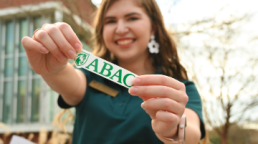

2. Authentic Portrayal of Peers
This is a big one — and a tough one. With so much user-generated content in social media, students are too savvy to fall for any depiction of diversity that feels forced. Often, schools get so sensitive about representing every possible identity group, that they fall into the trap of trying to ensure every photo represents every possible demographic at their institution. Research suggests that 88% of consumers (various ages and industries) say that authenticity is important in deciding which brands to support. That is even more true for digital natives!
TIP: While it’s okay to tip the scales a little by showcasing more of the populations you hope to increase, aim for authenticity in the mix of genders, cultures, and ethnic backgrounds. Balance can be achieved through a variety of images (rather than in each orchestrated shot), to ensure that your communications, as a whole, honestly reflect the identities within your student body. Also make sure that the scene feels real. Would these kids really be lounging on a picnic blanket in front of the school sign while laughing wildly? Ask your student “models” to help choose the spots that feel natural to them. When the participants are at ease, the resulting photo will be more authentic.
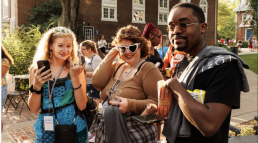

3. The Setting Is as Much a Character as the Individuals
Like hunting through a real estate website, viewers want to get a sense of the property before investing additional time in person. Through your communications, students want to get an idea of the home they’ll be renting for the next few years. How current are the research labs? Do the residence halls look comfortable? Is the surrounding area safe, with enough to do when you just need to get off campus for a bit?
TIP: Tightly cropped, dramatic images of teacher-student interaction are great, but be sure to show off your facilities, amenities, and what’s in the area just as much. The environments and creature comforts add to the value of the experience (and help validate the price tag for parents, too). Don’t forget to “dress things up” with brightly colored props or tinted lights for a dramatic look.

4. Strong Values Tie Into Good Value
Many college-bound students believe their education is a means to making a difference in the world. They feel duty-bound to initiate positive change and are optimistic about their powers to do so. To that end, they seek an environment that aligns with their vision. Parents examine the values projected by an institution (whether faith-based or secular) and the community within it. Will my child be in good company and influenced by the right peers? Will my child have the necessary support to reach goals, be fulfilled, and make a living?
TIP: Showcase opportunities outside the classroom that foster personal — as well as professional — growth through community service. Service trips abroad, working for Habitat for Humanity, and helping local food pantries by partnering with a sustainable farm, are all great examples of social outreach that students seek. Highlight moments of caring and support not only from faculty and administrative staff (such as career services), but also from students helping others and one another, as well. The culture of your campus community goes a long way to building an emotional bond with your prospective student families.
5. Bring Scenes to Life
We all know that campus beauty is often the first impression audiences get, and this attraction, like in dating, plays a big emotional part in falling in love. The luxurious aerial certainly has its place, but gorgeous scenery and stately architecture alone aren’t enough. Don’t forget all the memorable spots on campus — a cozy dorm room, a recognizable gazebo in the quad, a famous rock embedded in student traditions, or a popular selfie spot favored on campus tours.
TIP: Make sure to infuse life into these scenes by including people. Keep things fresh with new ways of capturing these moments. Challenge your photographer to create dynamic effects, such as blurred motion, or to change the vantage point by shooting from an unusual angle, such as 20 feet in the air or from an adjoining building. This may require some additional equipment, but the results will be worth it.
There is so much more that goes into scheduling the right shot list and capturing everything you’ll need in your institutional communications and publications. (We haven’t even touched on incredible outcomes stories!) But even if you have only a single day to devote to your shoot, capturing the key features is not that hard when you know where to focus.

About the Author
Irene has led countless photoshoots with a critical eye and a keen understanding of what images will be most effective in a wide variety of marketing materials. She’s also been known to bring an entire bag of colorful scarves as props to brighten a scene. Irene is happy to share her insights to help you capture the spark that sets your school apart. Reach out for more pro tips or to discuss your specific creative needs.
